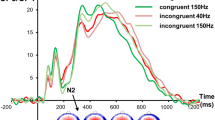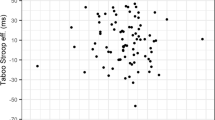Abstract
In this study, we simulate the dynamics of suppressing an automatic stimulus processing which interferes with a different non-automatic target task. The dynamics can be observed in terms of interference and facilitation effects that influence target response processing time. For this purpose, we use Hopfield neural network with varying attention modulation in a colour-word Stroop stimuli processing paradigm. With the biologically realistic features of the network, our model is able to model the Stroop effect in comparison to the human performance.
Access this chapter
Tax calculation will be finalised at checkout
Purchases are for personal use only
Similar content being viewed by others
References
Folk, C.L., Remington, R.W., Johnston, J.C.: Involuntary covert orienting is contingent on attentional control settings. J. Exp. Psychol. Hum. Percept. Perform. 18 (1992) 1030–1044.
Stroop, J.R.: Studies of interference in serial verbal reactions. J. Exp. Psychol. 18 (1935) 643–662.
Cohen, J.D., Dunbar, K., McClelland, J.L.: On the control of automatic processes: A parallel distributed account of the stroop effect. Psychol. Rev. 97(3) (1990) 332–361.
Phaf, R.H., van der Heijden, A.H.C., Hudson, P.T.W.: SLAM: A connectionist model for attention in visual selection tasks. Cogn. Psychol. 22 (1990) 273–341.
Hopfield, J.: Neural networks and physical systems with emergent collective computational abilities. Proc. Natl. Acad. Sci. USA 9(2554) (1982).
Popoviciu, N., Boncut, M.: On the Hopfield algorithm. Foundations and examples. General Math. 13(2) (2005) 35–50.
Dunbar, K., MacLeod, C.M.: A horse race of a different color: Stroop interference patterns with transformed words. J. Exp. Psychol. Hum. Percept. Perform. 10 (1984) 622–639.
Author information
Authors and Affiliations
Corresponding author
Editor information
Editors and Affiliations
Rights and permissions
Copyright information
© 2011 Springer Science+Business Media B.V.
About this paper
Cite this paper
Yusoff, N., Grüning, A., Browne, A. (2011). Modelling the Stroop Effect: Dynamics in Inhibition of Automatic Stimuli Processing. In: Wang, R., Gu, F. (eds) Advances in Cognitive Neurodynamics (II). Springer, Dordrecht. https://doi.org/10.1007/978-90-481-9695-1_95
Download citation
DOI: https://doi.org/10.1007/978-90-481-9695-1_95
Published:
Publisher Name: Springer, Dordrecht
Print ISBN: 978-90-481-9694-4
Online ISBN: 978-90-481-9695-1
eBook Packages: Biomedical and Life SciencesBiomedical and Life Sciences (R0)




